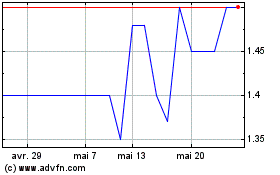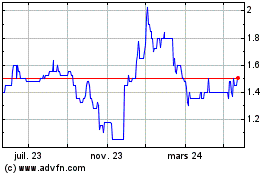Anglesey Mining PLC - Chairman's Annual Report Stmt
01 Octobre 1997 - 9:44AM
UK Regulatory
RNS No 5863h
ANGLESEY MINING PLC
1st October 1997
New Geological Assessment of Parys Mountain Property
In its Annual Report issued Monday Anglesey Mining plc chairman, John F
Kearney, told shareholders:
"The complete geological reassessment of the Parys Mountain property which
has been carried out by the company over the past two years has resulted in
the development of an exciting new geological model which indicates that
there is potential for the discovery of substantial additional mineral
resources at Parys Mountain."
Over the past two years the company has carried out a reassessment of the
geology and structural setting of the Parys Mountain deposit. This
programme has included a compilation and reinterpretation of drilling
results from the preceding three decades, as well as relogging of historic
drill core and remapping of surface geology. At the same time
lithogeochemical studies have been undertaken.
The results of the above work have led to the development of an exciting
new stratigraphic model for the Parys Mountain deposits which has
demonstrated that there is a potential for the identification of new
mineral zones on the property which could add substantially to the existing
mineral resource base.
New Geological Interpretation
The original open pit copper deposits at Parys Mountain were traditionally
viewed as vein systems or lodes within volcanic rocks. However the zinc,
copper, and lead massive sulphide mineralised zones, first discovered in
the early 1980s in the lower part of a thick sequence of volcanic rocks,
near the contact with underlying shales, are typical volcanic massive
sulphide deposits formed on the sea floor adjacent to submarine volcanoes.
Until recently it was generally accepted that the rock layers had been
folded into a large U or V shaped structure with an east west axis, the
occurrence of shales flanked by older volcanic rocks being taken as
evidence of this axis.
The work carried out by the company over the past two years has led to a
new understanding of the importance of the relationship between volcanic
rocks of differing characteristics and the massive sulphide mineralisation.
It is now thought that large scale folding is not a factor governing the
distribution of the various mineral bodies.
It is believed that the lenses of massive sulphide mineralisation at Parys
Mountain are located next to a series of eruptive centres or volcanic
domes, which can be defined and identified using chemical analysis of trace
elements in the rocks (lithogeochemistry).
This relationship between massive sulphide deposits and volcanic centres
explains the distribution of the already identified sulphide lenses and
provides strong evidence for a prospective area at least twice as large as
the area which contains the presently established resource of 6.5 million
tonnes.
Geology
The Parys Mountain polymetallic deposits are located in a sequence of
Ordovician to Lower Silurian volcanic rocks and shales. The massive
sulphide lenses lie mainly at or close to the base of a thick felsic
sequence, at or near the contact with underlying mudstones. These lenses
appear to have accumulated around the flanks of a series of felsic volcanic
centres or rhyolite domes at the base of the felsic volcanic sequence.
The new interpretation is that two north-easterly trending chains of
rhyolite domes are present, distributed over a length of 3 km. Diamond
drilling to date has focused almost entirely on the north-western flank of
the western chain where the Engine zones have been delineated. Only a few
widely spaced holes have been drilled on the south-eastern flanks of the
western chain, where a new zone, the Central zone is believed to located.
The flanks of the second chain of domes, which has been identified by
surface mapping, are almost totally unexplored. There are also indications
that larger lenses of massive sulphide may lie along the northern edge of
the Parys Mountain system at depths of 400m to 600m below surface.
Development Potential
The company considers that the property has the potential for a significant
increase in its resource base. Only the western 1 kilometre of a 3
kilometre east-west strike length has been subject to any meaningful
exploration and only the western fringe of this western 1 kilometre itself
has been subject to detailed assessment. The company believes that there
is considerable potential to identify and define new ore zones in the
remaining 2 kilometres of the property.
A new exploration programme was recently launched, which is expected to
include about 2,500 metres of diamond drilling during the remainder of
1997. An initial five holes are planned in unexplored areas east of the
already identified resource. "The objective of the new exploration
programme is to develop a significantly larger mineral deposit at Parys
Mountain" Mr Kearney stated.
Contacts :
Ian Cuthbertson John F. Kearney
Company Secretary Chairman
01248 361333 001 416 362 6686
END
MSCWBUBUBBGMPPU
Anglesey Mining (LSE:AYM)
Graphique Historique de l'Action
De Juin 2024 à Juil 2024

Anglesey Mining (LSE:AYM)
Graphique Historique de l'Action
De Juil 2023 à Juil 2024
